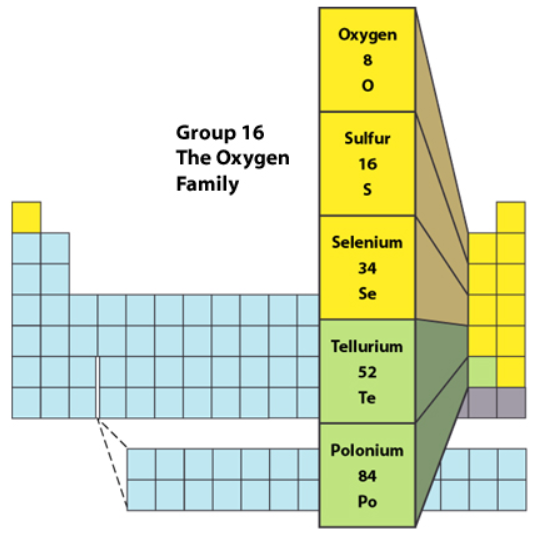General Introduction
The group 16 family is named after its first member, oxygen; however, the individual elements vary quite widely owing to the changing metallic properties going down the group. These elements are also called chalcogens that are derived from the association of sulphides and oxides in brass congeners (ore-forming) with copper. They are found in nature in both free as well as combined states. Their general electronic configuration is ns2np4. These elements have 6 electrons in the outer most valence shell and they either gain or share 2 electrons to make a stable shell.

The first two members of Group 16 and oxygen and sulfur. These elements are essential for all life forms. There are three nonmetalsoxygen, sulfur, and selenium and three metalloids tellurium, polonium and livermorium. Out of which the heavier two are radioactive. All of the chalcogens play some role in biological activities, either as a nutrient or a toxin.
Oxygen, like nitrogen, is a low-boiling diatomic gas, O2 found in the atmosphere at 20% concentration. Oxygen is also abundant in Earth’s crust form in stable rocks and minerals because it readily combines with other elements. Oxygen is the gas we breathe in to allow respiration and conversion of food into energy. Oxygen also is required for combustion to occur. Ozone, O3 is a less common form of oxygen. It is formed in the upper atmosphere due to lightning during thunder storms. The presence of ozone in the upper atmosphere is crucial. It shields the living organisms from some harmful radiation from the Sun. However, ozone also happens to be a dangerous pollutant at ground level due to high reactivity.
Sulfur, like phosphorus, occurs as a polyatomic molecular solid. Sulfur is a solid, yellow nonmetal. It can form a wide range of allotropes. Large amounts of sulfur are used to manufacture sulfuric acid, one of the most commonly used chemicals in the world. Sulfuric acid is a combination of sulfur, hydrogen, and oxygen. It is used in the manufacture of paints, fertilizers, detergents, synthetic fibres, and rubber
Selenium, like arsenic, is naturally found as a grey metalloid. It conducts electricity when exposed to light. Hence it is commonly used in solar cells, lightmeters, and photographic materials. It is most commonly used as the light-sensitive component in Xerox machines. Traces of selenium are also essential for vitamin supply in the body. Selenium itself is non-toxic, however, when mixed with other elements, e.g hydrogen selenide is highly toxic to humans.
Tellurium, like antimony, displays network covalent bonding. It is with some metals to brittle metalloid that can be alloyed with some metals to increase their machinability. It is also used in solar panels and memory chips for computers.
Polonium, like bismuth, has a metallic crystal structure. It is highly carcinogenic and radioactive. It is used in making nuclear weapons.
In 2012, another metal was added in the oxygen family, Livermorium which is a synthetic chemical element. It is highly radioactive and can only be produced in minute quantity.